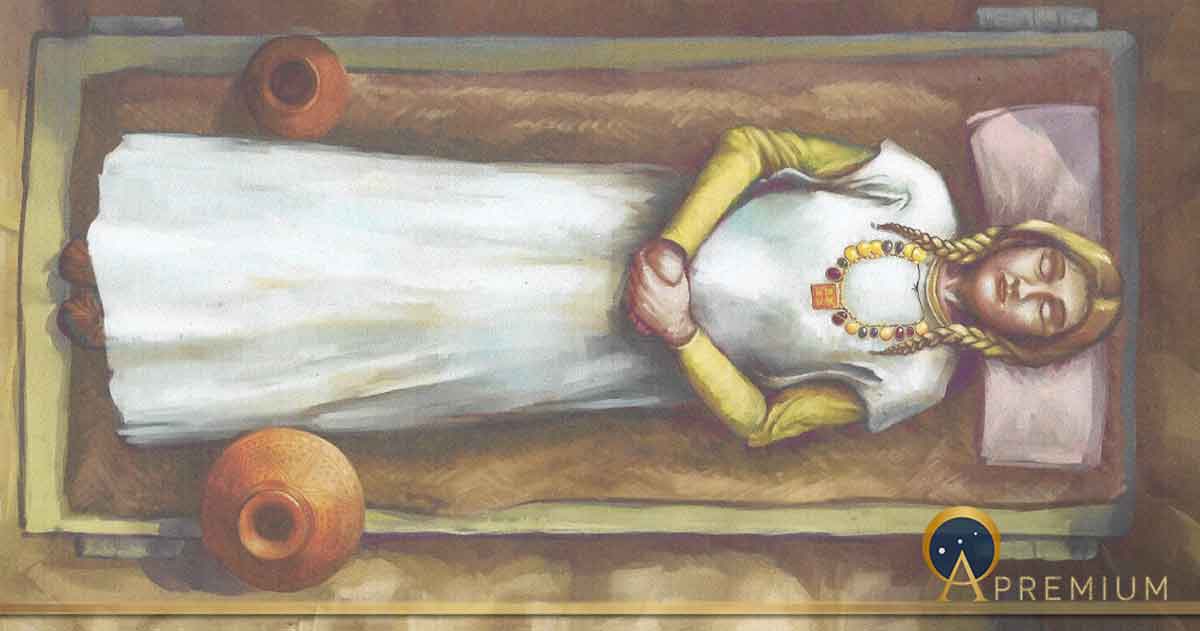Anglo-Saxon Bed Burials And Grandmother’s Featherbed
In April 2022, a ‘once in a lifetime” British archaeological discovery was made of a rare bed burial, accompanied by grave goods, known as the Harpole Treasure. So important and so vital was it to be carefully guarded from theft, that in every hurried phone call and messaging made during those first few days no-one involved even mentioned the word ‘gold’. Even more dramatic is the fact that this was found at the 11th-hour, on almost the last day of the eight-week dig. Speed was crucial and the day after the discovery two experts from the Museum of London Archaeology took the train to Northamptonshire to review the finds. The grave site turned out to be a rare seventh-century bed burial of a woman. In Old English Harpole means “filthy pool”. The bed did not survive as wood rarely does well underground unless left in a very damp and soggy place. Archaeologists recovered only a few metal pieces which had held the bed together, a few vertebrae bones of the skeleton and grave goods, one in particular which was outstanding. It was a gold necklace, one of the finest Anglo-Saxon jewels to be found in Britain. The Anglo-Saxons seem to have been just as mesmerised with gold and gold jewellery as almost every other ancient civilisation seem to have been.

The moment of uncovering the Harpole necklace (Image: with permission © MOLA)
Anglo Saxon Bed Burials
Most of the 18 bed burials from Saxon times are women’s graves, found either around Cambridge in East Anglia, or over to the west in Wessex which is modern day Hampshire. Wessex originally meant ‘West Saxons’. Both of these were among seven Anglo-Saxon kingdoms which existed by 556.
Mercia, which included Harpole, was another of the seven kingdoms, and eventually it would be Wessex which became most important of all and formed Britain into a single nation. Yet, Harpole was not a known Anglo-Saxon settlement or anywhere near one, and so the discovery opened up a new chapter for everyone involved with the dig. The woman buried in her bed could have been a princess or an Abbess; certainly she belonged if not to royalty then to one of the elite Saxon families as the wealth of her grave goods and burial indicate how important she was. Little was left of the skeleton which had almost all decomposed due to the acidic soil. The woman was accompanied by a superb gold necklace, evidential of the quality and outstanding craftsmanship of the gold.
Like this Preview and want to read on? You can! JOIN US THERE ( with easy, instant access ) and see what you’re missing!! All Premium articles are available in full, with immediate access.
For the price of a cup of coffee, you get this and all the other great benefits at Ancient Origins Premium. And - each time you support AO Premium, you support independent thought and writing.
Viki Holton is a Research Fellow (Adjunct) at Ashridge Executive Education, Hult International Business School. Her earlier interests in women in business and leadership has developed recently to include a book about women’s social history, a 1,000 years of women’s wills: A Woman’s Will: The Changing Lives of British Women told through the Things they have left Behind by Amberley Publishing.
Top Image: Artist’s impression of the Harpole Bed Burial (Image: with permission © MOLA)
By: Viki Holton
















